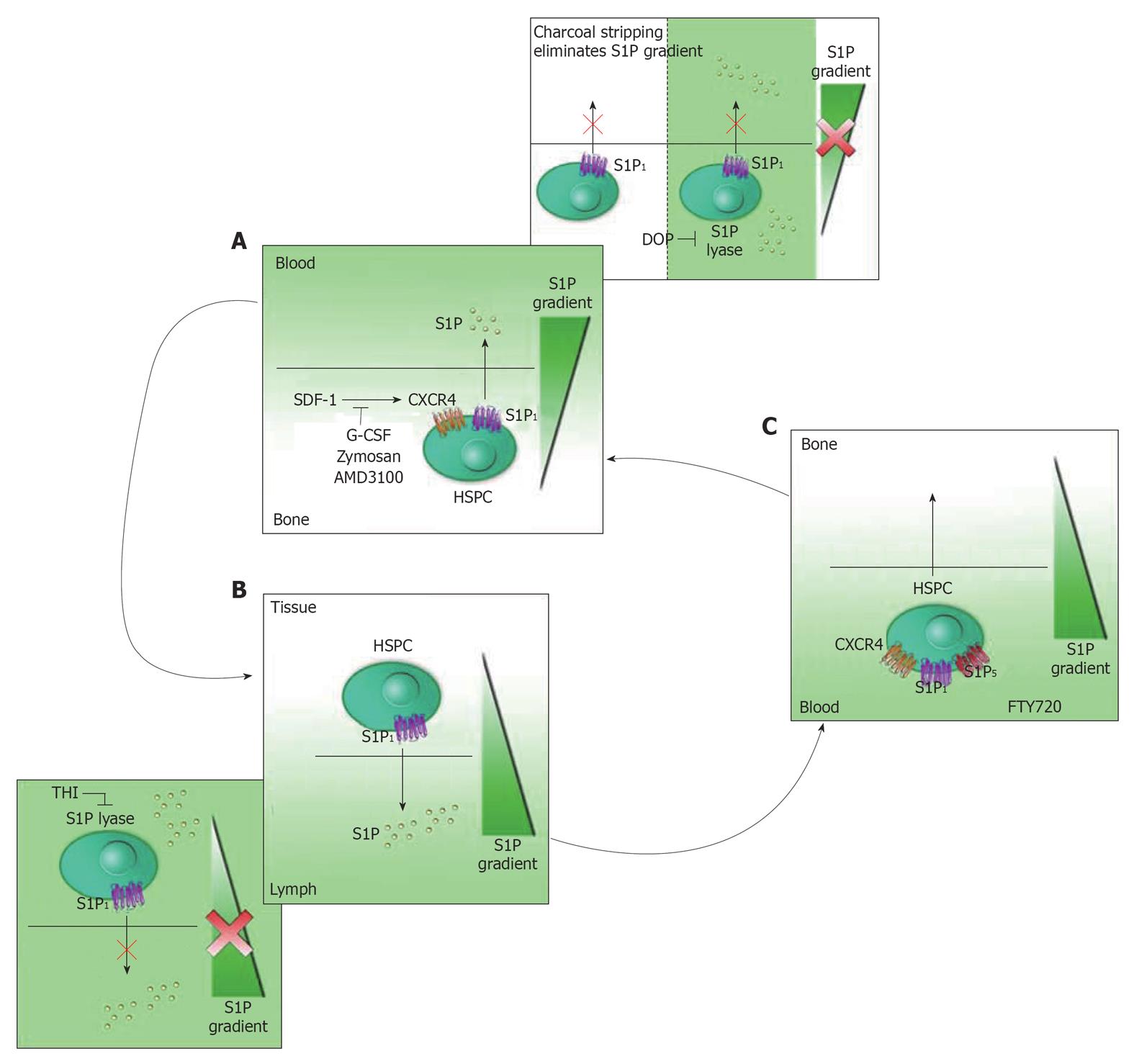Copyright
©2011 Baishideng Publishing Group Co.
World J Biol Chem. Jan 26, 2011; 2(1): 1-13
Published online Jan 26, 2011. doi: 10.4331/wjbc.v2.i1.1
Published online Jan 26, 2011. doi: 10.4331/wjbc.v2.i1.1
Figure 1 Model of the differentiation and migration of osteoclasts precursor myeloid lineage progenitor cells and osteoblasts precursor mesenchymal stem cells in response to sphingosine-1-phosphate gradient.
Pre-osteoblast cells express sphingosine-1-phosphate (S1P)2 to repress it chemotaxis towards platelet derived growth factor (PDGF). After bone morphogenetic protein 2 (BMP2)- induced differentiation of pre-osteoblasts (OB) to OB, S1P2 is down-regulated to resume the chemotaxis to PDGF. The migration of osteoclasts (OC) precursor myeloid linage progenitor cells to blood system is mediated by the S1P1 receptor. During receptor activator for nuclear factor κB ligand (RANKL)-induced OC differentiation, S1P1 expression is suppressed to favor the local bone localization and bone remodeling.
Figure 2 Model of sphingosine-1-phosphate gradient in hematopoietic stem progenitor cell trafficking.
A: Egression of hematopoietic stem progenitor cells (HSPCs) from bone marrow (BM) to peripheral blood. The molecular interactions of stromal cell-derived factor 1 (SDF-1)/CXCR4 and other adhesion molecules mediate the lodgment of HSPCs in BM niches. Blockage of the key retention signal SDF-1/CXCR4 with granulocyte colony-stimulating factor, Zymosan and CXCR4 antagonist AMD3100 promotes HSPC mobilization from bone morrow and release to peripheral blood. Eliminating sphingosine-1-phosphate (S1P) gradient either by charcoal stripping or blocking S1P lyase activity inhibits the HSPC mobilization to PB (pink-colored framed); B: Egression of HSPCs from tissue to lymph. HSPCs stay in tissue for a short time and then egress to lymph in response to S1P gradient. The disappearance of S1P gradient by the treatment of S1P lyase blocker THI causes the HSPCs be unable to enter lymph (pink-colored framed); C: Homing of HSPCs from blood to BM. FTY720 may promote primitive HSPC movement to BM through S1P1 and S1P5, or it may synergize with SDF-1/CXCR4 signaling for efficient HSPC homing and engraftment to BM. G-CSF: Granulocyte colony-stimulating factor.
Figure 3 Stem cell trafficking to injured tissues.
A: Retention of hematopoietic stem progenitor cells (HSPCs) in local tissue. HSPCs can down-regulate the expression of sphingosine-1-phosphate (S1P)1 in response to lipopolysaccharide and thus stayed in local tissue and could differentiate to multilineage cells to help clear the infection; B: Trafficking of mesenchymal stem cell (MSC) to injured liver. S1P is elevated in response to liver damage, which attract bone marrow MSC to the injured liver for liver remodeling in a S1P3 dependent manner.Sph, sphingosine; SPHK, sphingosine kinase; C: Targeting of neural progenitor cell (NPC) to the site of brain injury. NPCs are found to migrate to the site of injury for local regeneration. This is regulated by the down-regulation of S1P2 receptors; D: Migration of endothelial precursor cell (EPC) to sites of vascular injury. EPCs migrate to vascular injury due to high S1P generated from local vessel leakage and platelet clotting. This is probably mediated by the S1P3 receptor subtype. BV: Blood vessel.
- Citation: Liu J, Hsu A, Lee JF, Cramer DE, Lee MJ. To stay or to leave: Stem cells and progenitor cells navigating the S1P gradient. World J Biol Chem 2011; 2(1): 1-13
- URL: https://www.wjgnet.com/1949-8454/full/v2/i1/1.htm
- DOI: https://dx.doi.org/10.4331/wjbc.v2.i1.1











